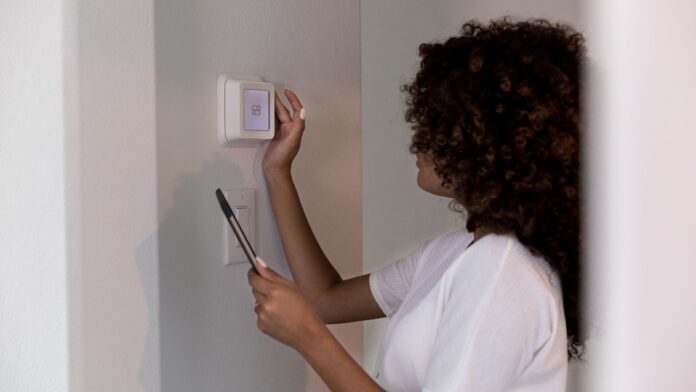Cleveland winters are notorious for their cold and snow, which can lead to high heating bills. However, there are practical steps you can take to keep those costs down. From simple lifestyle changes like adjusting your thermostat to affordable upgrades like draft stoppers and smart thermostats, these tips will help you save money without sacrificing comfort.
1. Adjust Your Thermostat Settings
One of the easiest and most effective ways to lower heating costs is by adjusting your thermostat. For every degree you lower the temperature, you can save about 1% on your heating bill.
- Lower your thermostat at night: Drop the temperature by 7-10°F while you’re sleeping or away from home. A comfortable setting of 68°F while you’re awake and lower when you’re sleeping or away can make a significant difference in your energy usage.
- Invest in a programmable or smart thermostat: Programmable thermostats allow you to set different temperatures for different times of the day. Smart thermostats, like the Nest or Ecobee, go a step further by learning your schedule and automatically adjusting the temperature. These devices are affordable and can reduce heating costs by up to 10-12% annually.
Tip: Bundle up with blankets and warm clothes to stay comfortable while your thermostat is set lower.
2. Seal Drafts and Insulate Your Home
Cold drafts from windows, doors, and other gaps can significantly increase your heating costs by allowing warm air to escape. A few affordable products and techniques can help prevent heat loss:
- Use draft stoppers: Draft stoppers (or draft snakes) are inexpensive tools that you can place along the bottom of doors and windows to block cold air from seeping inside. You can even make your own using rolled-up towels or socks.
- Weatherstripping and caulking: Weatherstripping for doors and windows seals gaps and prevents drafts. Caulking around window frames and baseboards can also help block out cold air.
- Insulate outlets and switch plates: Exterior-facing electrical outlets and light switch plates can be sources of heat loss. Insulating foam gaskets, which are affordable and easy to install, can block these small leaks.
Tip: Check for drafts around windows and doors by holding a candle near the edges. If the flame flickers, you’ve found a draft that needs sealing.
3. Take Advantage of Sunlight
Even during Cleveland’s harsh winters, sunlight is a free and natural source of heat. Maximizing sunlight in your home can help warm it during the day.
- Open curtains during the day: Open curtains or blinds on south-facing windows to let in as much natural sunlight as possible. The sun can provide a surprising amount of warmth, even on cold days.
- Close curtains at night: Once the sun sets, close your curtains or blinds to trap heat inside and block cold drafts from windows. Using thermal or insulated curtains can further help reduce heat loss.
Tip: Consider investing in insulated curtains, which are designed to block drafts and keep heat from escaping through your windows.
4. Use Space Heaters Wisely
Using space heaters can be an efficient way to heat specific rooms rather than heating your entire house. However, they should be used with caution and only in the rooms you occupy frequently.
- Heat only the rooms you’re using: Space heaters are most effective when used in rooms where you spend the most time, like the living room or bedroom. This allows you to lower the thermostat for the rest of the house.
- Choose energy-efficient models: Look for space heaters with built-in thermostats and energy-saving settings to prevent overheating and unnecessary energy use.
Tip: Always follow safety guidelines when using space heaters, such as keeping them away from flammable materials and turning them off when you leave the room.
5. Maintain Your Heating System
A well-maintained heating system operates more efficiently, helping you save on your energy bills. Regular maintenance ensures that your furnace or heat pump isn’t working harder than it needs to.
- Change your air filters: Dirty filters make your heating system work harder, using more energy. During winter, change your filters every 1-2 months to keep air flowing freely.
- Schedule annual furnace tune-ups: Professional inspections and tune-ups can identify issues before they become costly problems and ensure your system is running at peak efficiency.
Tip: If your furnace is more than 15 years old, consider upgrading to a newer, energy-efficient model, which can save you up to 20% on heating costs.
6. Use Rugs and Carpeting
Bare floors, especially hardwood or tile, can feel cold underfoot and allow heat to escape. Adding rugs or carpeting can make rooms feel warmer and cozier.
- Place rugs in high-traffic areas: Large area rugs in living rooms, hallways, and bedrooms can help retain heat and add insulation.
- Use padding under rugs: Rug pads add extra insulation between the floor and rug, further preventing heat loss.
Tip: In addition to retaining heat, rugs provide a cozy, comfortable surface to walk on, making your home feel warmer overall.
7. Install or Upgrade Insulation
While it may require a bit more investment, upgrading your home’s insulation can provide significant savings on heating bills in the long run.
- Insulate your attic: Heat naturally rises, and without proper attic insulation, much of your home’s warmth can escape. Adding insulation in the attic is one of the most cost-effective ways to reduce energy loss.
- Insulate walls and floors: If your home is older, it may benefit from additional insulation in exterior walls, basements, or crawl spaces.
Tip: You may be eligible for tax credits or rebates for installing energy-efficient insulation, so check local programs before upgrading.
8. Reverse Your Ceiling Fans
Ceiling fans aren’t just for summer—using them in winter can help distribute warm air more evenly throughout your home.
- Reverse the direction: Set your ceiling fans to rotate clockwise on a low speed during the winter months. This pushes warm air that collects near the ceiling down into the living space, keeping the room warmer.
Tip: Make sure your fan is running at a low speed to avoid creating a draft.









